1. There is a God and he must be a Trini
After a lacklustre opening night, Sonia Noel must have been praying for a miracle. She got an answer in the form of Trinidadian soca powerhouse Shurwayne Win-chester, who along with an assembly of regional and local designers put on a high-fashion display. A sea of colour bathed the catwalk, the most jarring improvement over the drabness of the previous night.
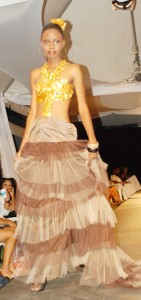
Winchester, whose musical eclecticism seemingly rivals only countryman Machel Montano, debuted his “Paradisin’” line, his first foray into fashion designing. He showed a full collection of semi-casual and formal men’s and women’s wear. He selected a bright palette of colour, including orange, lime-green and sea-blue which combined for distinctive compositions. His success in music is due in large part to his eclecticism, a quality that was also very much visible in his designs. He favoured layers, in the clothing as well as the patterns.
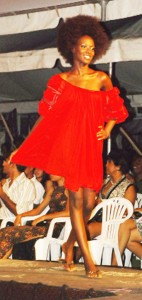
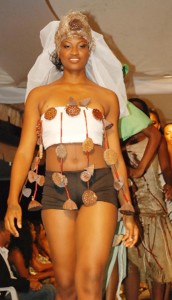
At the end of his collection he also treated the audience to a live performance, thrilling adoring fans with his dance moves. It seemed so unfair to the other designers who were asked to follow him.
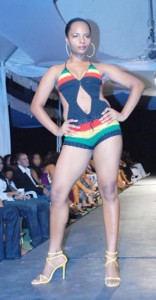
Winchester’s fellow twin island designers did not disappoint either. Dominic La Roche, never one to shy away from theatrics, also made an impression with his DLRD line.
I saw him at GFW last year and I remember being stunned when I saw models walk out onto the stage with what looked like funereal veils (the kind usually worn by the wives of slain mobsters and other important people in film). My impression was that he was simply negating the personality of his models, in order to keep the focus on the clothes (an idea that gained more currency when he simply peeped out at the end of the showing and quickly ran back off-stage). Now, I wasn’t sure what to think. In comparison to his countryman, Robert Young, LaRoche’s concept was as clear as day. In fairness, Young’s “The Cloth” was quite possibly the most important collection on show-in terms of its fusion of style and substance-but at times he ran the risk of going over the heads of the audience, which he encouraged to scrawl messages of peace in chalk along the runway as his models paraded by. It seemed almost redundant that he would wear a t-shirt emblazoned with the slogan: “Black men are good.” Diane Hunte of radical Designs, meanwhile, made good clothes for all men, filling up the huge gap for men’s wear on the catwalk.
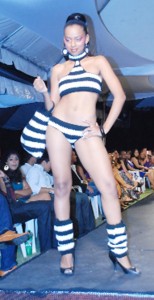
Antigua’s Junay Powell showed “Intoxication,” a stunning collection of hand-knitted beach wear. The purples and blues in addition to an imaginative ice, gold and green motif were very expressive; meanwhile, the BVI’s Kristin Frazer used a simple black and white colour scheme to create two-toned designs that packed a punch.
2. Sex and sensitivity
Does the fashion industry exploit women? That’s a no-brainer, given the “ideal woman” image that it has sold for years. Think of the waif thin models who still earn a good living, even if they don’t use it to buy food. Feminists have long labelled the industry sexist-a point hardly mitigated by the men who have ruled the roost. Many great designers (Dolce and Gabana immediately come to mind and even perhaps Tom Forde) have sought to subvert the exploitative nature to runway to empower women.
Marilyn Manson’s “This is the new shit” blared from the sound system as models, mostly decked in mostly full flowing outfits, walked out on the catwalk and assumed a series of exasperated poses. They carried placards with anti-violence messages like: “Make love not war,” “Black eyes are not cute,” “My body is a temple, respect me,” and “Break the cycle; take control.”

Simultaneously the display screen set up at the side of the main tent flashed newspaper clippings about the Domestic Violence Act.
GFW CEO Sonia Noel told me that she was approached just two days before by Human Services Minister Priya Manickchand, who thought that the runway would be a good medium to publicize the campaign against domestic violence. She said there had been plans for a collection to feature all the designers and as a result “Stamp-it Out” was adopted as the theme around which they created their designs. It was an inspired idea and hopefully one that starts a dialogue on how fashion (and hopefully beauty pageants) really affects the women in our society. Ultimately, it ought to be said that designers hardly ever have control over what their creations symbolize once they are on the catwalk. Remember, once the clothes hit the runway, they are moved beyond the designer’s intention. They belong entirely to the audience, which may make of them whatever it wishes.

Noel herself led a strong line-up of local designers who were not outdone by their regional counterparts. The pieces from her Mariska’s Design label married sensuality with elegance. Noel also could not resist her own high concept muse, managing to incorporate actual condoms in six of her dresses, doing her part to draw attention to the HIV/AIDS awareness campaigns.
Meanwhile, those fabulous Telford sisters (Nadine and Nikisha), who were acclaimed when they debuted last year, did not disappoint. Their line of evening dresses, “Shengon,” drew inspiration from traditional Chinese dresses.
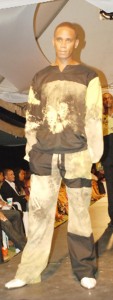
The young sisters, known for their sexy body-hugging outfits, were after a more mature look. Their pieces were chic though not at the expense of seductive. Add to that accessories that included swords and daggers (Yes!) and giant fabric hand fans (Yes! Yes!), which is exactly the kind of I-kid-you-not unexpected s#!+ one comes to wish for at events like this, and they had a bonafide hit on their hands. So did Carol Linde who clearly put paid to the idea that local materials are sub-par for design. She also scored points for creatively using bamboo seeds (?) and dried water lilies to garnish her creations. Sonola Forte’s “Textures and Tones” from her Bumblebee Collection and Sonjay and Alan Marslowe also earned favourable reviews for their collections.
3. Are you gay?
Melissa’s question was obviously tongue-in-cheek, but nevertheless quite understandable. Watching a near endless succession of scantily-clad women parade past you can get boring after a while. Really. Besides, on the catwalk, it’s not sex that sells it’s the lack thereof. Strangely, the idea that a woman is so out of your league that you’d never have a chance outside of the remote possibility that all the inhabitants of the earth with a T-chromosome drop dead, tends to make her that much more attractive. The models set the mood.
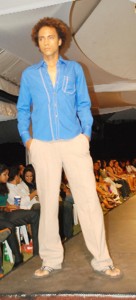
They have to walk a fine line between availability and unavailability. Too available and you’re needy, which nobody likes. Too unavailable and you’re snooty, which some people like. At the moment, another Melissa-former Miss Guyana/Universe Melesa Payne-just might be the best local model on the catwalk. To her credit, Payne navigates her in between both extremes. Her demeanor was generally reserved, but she smiled and strutted at precisely the moments it was called for. It was not surprising that she was the only model to win genuine cheers from the crowd whenever she stepped on the runway.
4. Beautiful Day
The night was an unqualified success. It erased fresh memories of the previous night’s debacles (although MC Walter Green seemed to keen to pick right where he left off the night before. (Introducing Winchester’s line: “Paradesis.” And then: “Paradisis?” Finally, after the singer corrected him: “Paradisin’. Okay.” And later, once more getting it wrong: “Paradesis. Did I say it?”) Also, the introduction of the live band was a good idea. The introduction of Mario Amres’ Inner Power Band was not-a fact quickly confirmed as he proceeded to mangle some of the easiest covers of songs by bands like U2 and Maroon 5. It was laugh-out loud funny when Green ended up clashing with the band. “Can we cut the vocals so we can introduce the designers?” Green yelled as an oblivious Amres cut deep into U2’s “Beautiful Day.”
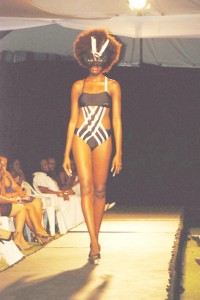
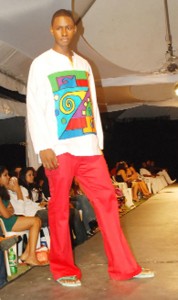
The night’s surprise, however, had to be Carlos ‘Lucky B’ Williams and the fact that his collection was not a complete train wreck. I could not have seen that one coming. Williams’ designs were actually quite tasteful – particularly his men’s wear -although the bikinis seemed to be plucked from the cliché catalogue. For a musician who has had a middling career so far, he just might have a future as a designer – a sentence I never thought I would write. Now I know there must be God, Trini or not.





